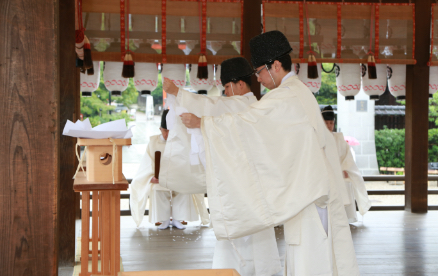Tsukinami-sai
The monthly festival was attended by the ujiko.
(people under the protection of the local deity)
January

Genshi-sai
This is a kind of a new year's festival.
Karuta-Hajime
(Ceremony of the first Karuta play of the new year)
Dedication of the Karuta play, a Japanese traditional card game held by the Japanese Karuta House.

Wakana-sai
Wakana means "young green". They offer young green to God and pray for happiness.
Ebisu-sha-sai(Yoi Ebisu)
The ship of shichifukujin marches around the Shijo street.

Ebisu-sha-sai(Hon Ebisu)
(9~10th day)Prayers for prosperity and security of family.
(We present souvenirs in front of Ebisu-sha on the 9th and 10th days.)
Seijin-sai(Coming of age festival)
Celebrating their participation as grown-ups and pray for happiness.
eki-jinja-sai
Prayers to drive out bad luck at eki shrine
February
Setsubun-sai
Prayers for health and happiness. Ponto-cho(01:00 pm) and Miyagawa-cho(03:00 pm) dedicate dances. We scatter beans and rice cakes.

Setsubun-sai
Same as above, Imayo(11:00 am), Gion kobu(01:00 pm), Gion higashi(03:00 pm) dedicate dances.We scatter beans and rice cakes.
On both days, we offer happy beans and Amazake, a sweet drink made from rice and sake.
Kigen-sai
We pray for the establishment of the country, prosperity of the nation and happiness of people. They dedicate a Seishin-ryu Ginbu dance and serve you with rice cakes.
March
Kinen-sai
Prayers for luxuriance with music and dance.

Shunbun-sai
Prayers for the coming of spring.
April
May
Tango-sai
Prayers for the health and happiness of their children.
Onzo-sai
Offering of summer clothes to deities.
Onda-sai
Rice planting performance in the sacred rice field in Tanba-cho

June
Mikagura-hono(Dedication of Kagura)
Kagura is sacred dance and music performed on the occasion.

Rei-sai
A large festival held on the day connected with the God. They also dedicate Kagura.

Ken-ei hikou-shiki
Performance of Ayanokoji-ryu tanka poetry.

Suzu-no-o hono hokoku-sai
Dedication of the cords of bell.
oh-harae-shiki
A ceremony for purification of sins.

July
7/1-31
Gion Matsuri(Gion Festival)
Held between July 1 to 31.
Many events are held during the festival. The
highlights are Yoi-yama on the 16th and Yamahoko-
junko on the 17th.
Also Hanagasa-junko happens on the 24th and ends
with the Eki-jinja nagoshi-sai on the 31th.
August
Tanabata-sai
An exhibition of children's drawings.

September
Shuubun-sai
A festival for the coming of Autumn.
Kangetsu-sai
A festival of moon viewing held on Buden.

October
kanname-sai-housyuku-sai
The day on which the emperor offered the new grains to the Gods
November
Shichigo-san moude
Meiji-sai
Mourning of and giving thanks to the Meiji emperor.
Onzo-sai
Offering winter clothes to deities.
Bugaku-hono(Dedication of Bugaku)
Dance dedication with a big drum and other music.

Niiname-sai
Offering of the first crops and praying for luxuries.

December
Susuharai
A ceremony of housecleaning in the shrine.
Tencho-sai
Celebration of the birth of the emperor and prayers for his long-lived life.
Sanka-shiki
The chief priest of the shrine ignites a fire by using the mallet and the mortar made from the hinoki tree. He then lights the Okera Tourou ("tourou" means garden lantern). The fire is kept burning in the main shrine throughout the year.
Oharae-shiki
A ceremony for the purification of sins.
Joya-sai
After the festival, the Okera fire is moved to the two Okera Tourou. People ignite the lantern's matchlock with the sacred fire then carry the lantern back home to ignite a candle before the home altar. They make zouni (rice cakes boiled with vegetables on New Year's Day) by that fire and pray for happiness during the new year.
Imamiyaebisu-jinja tai hono
On every new year's eve, Imamiyaebisu shrine offers breams to Yasaka shrine.

